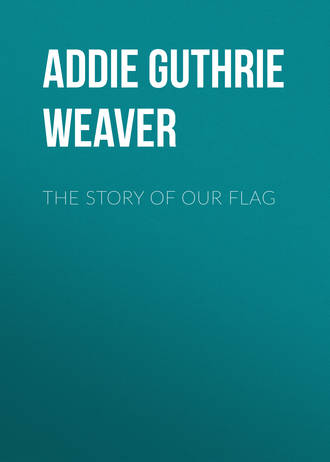 полная версия
полная версияThe Story of Our Flag
Sacred history is full of instances of the consecration of tassels and peculiar fringes to special sacerdotal uses. Blue was early the emblem of purity and innocence and that fact accounts for the predominance of that color in the ecclesiastical badges of these early times. When the use of the tassels passed into profane customs, they were used as ornaments for national standards and for royal girdles, and it was not infrequent that they were first blessed by the priests. It has followed naturally that this use has continued up to the present time, although now it is retained probably because of the artistic effect of the swinging pendants.
THE LINCOLN FLAG
Presented by the French People.
The flag in the White House which formerly hung in the center of the largest window in the east room, has a unique history.
It is woven of silk in one piece without a seam. There are gold stars in the field and among them are seen the words in French, “Popular subscription to the Republic of the United States, offered in memory of Abraham Lincoln. Lyons, 1865.”
STATE FLAGS
As the colonies had their flags of different kinds so the states one by one adopted special flags and nearly all the states of the Union now have a state flag or regimental color. In some states this emblem is established by law, in other states by the military department or the governor. There are a few states in which this special flag is covered with particular devices chosen by the caprice of the donor or the officials by whom the flag was authorized, but in all these cases, the state arms form a part of the emblazonment. There is a general feeling, however, that these special states flags should have no legal recognition, and that the only flag to be thus recognized should be the Stars and Stripes.
ORIGIN OF THE FLAG OF TRUCE
It is interesting to know how and why the little white flag which is always looked upon with breathless interest in the emergencies that call it forth, first came to be used.
When carried by the lone soldier on horse or on foot between the armies it has a significance that is always respected, and on the sea the hoisting of this flag at the ship’s mast or the carrying of the flag of white by boat to the enemy stops the firing of the guns. The custom originated in the church in the tenth or eleventh century.
Curiously enough while it is the only flag that is to-day used by all nations of the earth alike, no regularly made flag of truce is found in the flag lockers of nations. It is improvised when the emergency arises for its use. In the late war with Spain, such flags of truce as were used were made of blankets, sheets, table cloths. It is a flag that commands the enemy’s respect. An account of the origin of the flag of truce lately published, is as follows:
“La peace et la treve de Dieu” (The peace and the truce of God) was an agreement between the turbulent barons and the church, as severe injury and loss was most frequently the result of the private warfares which constantly raged.
To protect itself, but more especially to preserve justice and moral order, the church established a system which has exercised a beneficent influence down to this day.
The agreement stipulated a cessation of hostilities on certain festivities and saint’s days, and from Saturday to Monday. The barons and warrior class pledged during the time of war to extend full protection to women, pilgrims, priests, monks, travelers, merchants and agriculturists; to abstain from the destruction or injury of farm implements, the burning of crops, and the killing of live stock of the peasants. Penalties in violation of this agreement comprised money fines, bafflings, banishment, and excommunication.
Originating in the south of France this system was soon adopted through the whole of France, Italy, Spain, Germany, and England, and in 1095 Pope Urban II. proclaimed its universal extension throughout Christendom.
In time the Crown assumed this protective power, and the phrase was changed to “La paix et la treve du Roi,” or “The peace and truce of the king.” The republics recognized the time-honored institution, and the simple unfolding of a white cloth will instantly cause a cessation of hostilities. The adoption of a white emblem appears to be lost in tradition, as authorities do not reveal it. Doubtless it is similar, or may have arisen through a belief in the white Samite which shielded the Holy Grail from the gaze of unbelievers. Emblematic of purity, associated with the mythical knights of the Round Table, and used in the Crusades, it is probable that this sacred truce flag may have originated from the Samite of the Holy Grail.
At the present time, if presented during an engagement firing is not required to cease; nor, if the bearer be killed or wounded, is there ground for complaint. The truce emblem can be retained if admitted, during an engagement. Penalties are incurred if the truce emblem be wrongfully used, the severest being the ignominious death of a spy.
The following was written at the tomb of Washington in 1833 by Dr. Andrew Reed, English philanthropist:
WASHINGTON


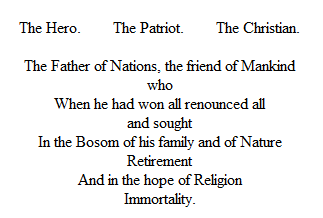
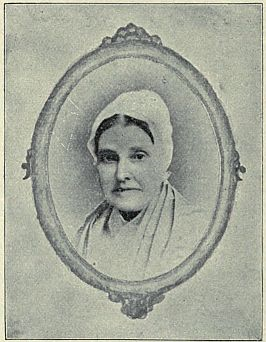
JANE CLAYPOOLE CANBY,
Fourth Daughter of Betsy Ross.
SKETCH OF BETSY ROSS AND HER HUSBANDS
Elizabeth Griscom, a daughter of Samuel and Rebecka (James) Griscom of Philadelphia, was born January 1, 1752. They were “Friends” and the young Elizabeth grew into a most charming, bright and beautiful girl of prepossessing manners and plain and quiet tastes.
Her father was a noted builder and assisted in the erection of the state house, now Independence Hall. His house, shop and a very large garden were on Arch street, between 3d and 4th streets.
Elizabeth, or Betsy, as she was fondly called, was the seventh daughter. Her birthday was the first day under the new Gregorian calendar.
It was frequently said by the family that “she was born the first day of the month, the first day of the year, the first day of the new style.” She was well trained by her mother, became very expert with her needle and was very fond of embroidery.
Among her many admirers was John Ross, son of Æneas Ross, assistant rector of Christ Episcopal Church. The young man was a nephew of the Hon. George Ross, delegate to Congress, one of the signers of the Declaration of Independence.
In December, 1773, at the age of twenty-one years, Elizabeth married John Ross, an estimable young man. He was an Episcopalian, and in consequence of her marrying out of meeting, she was disowned by the Friends.
The first husband of Betsy Ross was of distinguished ancestry. The Hon. George Ross, of New Castle, Delaware, had by his first wife, two sons: John, who died May 5th, 1776; and Rev. Æneas, born Sept. 9th. 1716, who was father of John Ross (husband of Betsy Ross).
By his second wife he had Hon. George Ross, signer of Declaration of Independence, born 1730, died 1780; also one daughter, Gertrude, who married George Read, also a signer of the Declaration of Independence; also a son, Jacob, a physician.
The Hon. George Ross was a noted lawyer, and a resident of Lancaster. He was a brave soldier and a man of ability.
John Ross was an apprentice with a man named Webster, an upholsterer on Chestnut street. It was with him that John and afterwards Betsy, learned the trade before they “ran off” to be married.
They then set up business for themselves, first on Chestnut street and afterwards moved to the little house on Arch street, which was a simple building when first occupied by them. It was built some time after 1752, notwithstanding romantic stories to the contrary. The first room was utilized as a shop; the store front not having been added until about 1858.
It was in this house that the flag was made later on.
In 1775 John Ross was injured while guarding military stores on the wharf, from the effects of which he died at this house in January, 1776. He was buried in Christ Churchyard, 5th and Arch streets. He left no children.
Mrs. Ross continued the upholstery business and the manufacture of flags.
Betsy Ross married for her second husband, at Old Swedes Church, Philadelphia, Captain Joseph Ashburn, June 15, 1777, and to them were born two daughters:
Jillah, born September 15th, 1779. Died young.
Eliza, born February 25th, 1781. Who married Capt. Isaack Silliman, May 29th, 1799. After Capt. Silliman’s death in the army, his wife Eliza lived with her mother, Betsy Ross, until her death in 1836.
To them were born four children:
Joseph Ashburn; Emilia; Jane; Willys.
Emilia left one daughter, Mrs. Mary Sidney Garrett, a widow and childless. She is the only living descendant of the second marriage.
Joseph Ashburn was taken prisoner by the British on the sea, and with the other soldiers was taken to England where he died in Mill Prison, March 3d, 1782. The prisoners were all given an opportunity to enter the British service, and on their refusal were thrown into prison. John Claypoole, a comrade, and also a prisoner of war, nursed and cared for Ashburn until he died. He brought home to his widow, on his release, the diary of Ashburn, together with messages to his wife, with whom he fell in love and afterward married.
John Claypoole, son of William and Elizabeth Claypoole, of Philadelphia, was married to Elizabeth Ashburn (Betsy Ross) the 8th of May, 1783, at Christ Church. His ancestor was James Claypoole, who came to America as the friend of William Penn; and from whom all the Claypooles mentioned are descended. He was a brother of Sir John Claypoole, who married Elizabeth, daughter of Oliver Cromwell.
The children of John and Elizabeth Claypoole were: Clarissa Sidney, born April 3, 1785, 9 a. m.; Susanna, born November 15, 1786, 4 p. m.; Rachel, born February 1, 1789, 7 p. m.; Jane, born November 13, 1793, 7 p. m.; Harriet, born December 20, 1795, 5 a. m., died October 8, 1796.
There is an old Bible over a hundred years old, which has a record of all these births and those of the Ashburn daughters; and of the deaths in the handwriting of John Claypoole. It was “The legacy of Sarah Hallowell to her niece, Elizabeth Claypoole,” that is, Betsy Ross.
John Claypoole was wounded in the battle of Germantown which, with imprisonment and the hardships of war, so impaired his health that he never regained it. So it may be truthfully said that the lives of her three husbands were sacrificed to their country, and her experience in these very important events in her life is certainly heroic. John Claypoole died August 3, 1817.
Betsy Ross attended Christ Church, Philadelphia, with her first husband and after his death continued in attendance until the Free Quaker Society was organized in 1793. The pew in which she sat was quite near one occupied by Gen. Washington, and is marked by a brass plate bearing these words:
“In this pew worshipped Betsey Ross, who made the first flag.”
All Friends who took part in the Revolution were disowned by “The Society of Friends.” After the war, they organized a society of “Free Quakers” often called “Fighting Quakers.”
As the time went by, nearly all were taken back into the original “Society of Friends,” but Clarissa Wilson and John Price Wetherell, of Philadelphia, were the last of the Free Quakers. They used to attend the little meeting house at 5th and Arch streets until there were just the two of them. In the fall of 1830 they decided it was unwise to have the little meeting house heated for them, so after that Clarissa Wilson attended the Orange street meeting house, but was never again received into the original society. She did not wish to be. She died a Free Quaker. Betsy Ross, her mother, lived to be 84 years old and died in 1836. The following are from the original autographs of Betsy Ross and her husband:
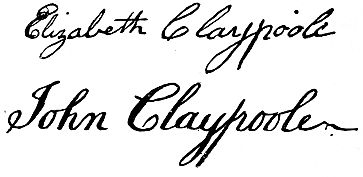
CHILDREN OF JOHN AND BETSY ROSS CLAYPOOLE
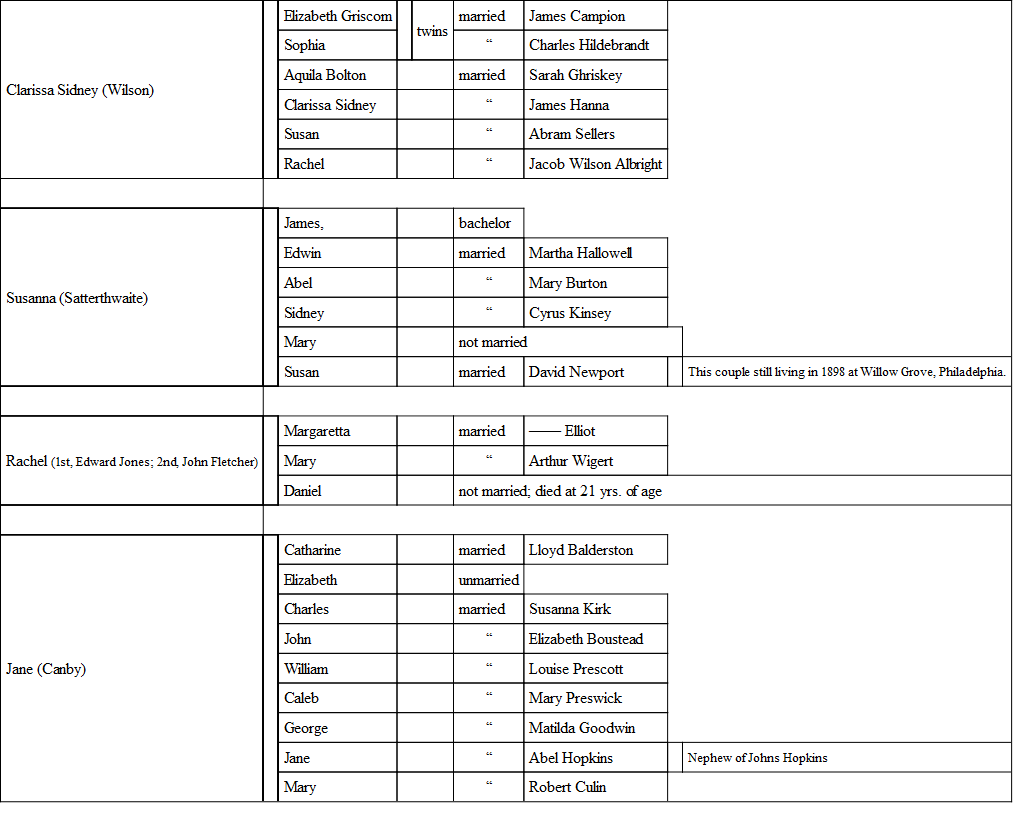
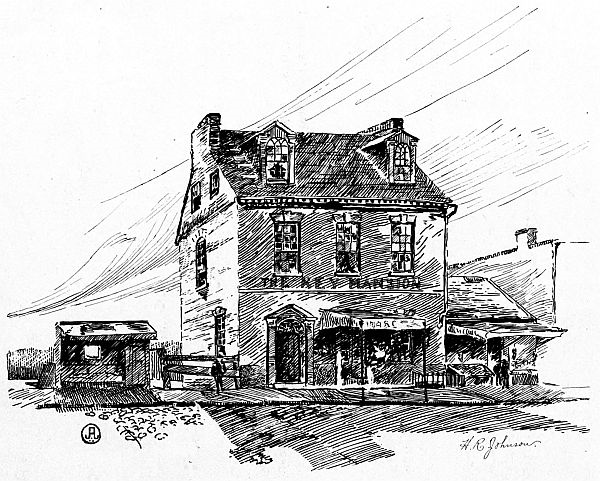
THE OLD KEY MANSION
The old Key mansion is one of the historic places that still remains on the banks of the Potomac in Georgetown, to remind us that here lived Francis Scott Key, the author of the national hymn “The Star Spangled Banner.” In unveiling to him the monument which had been erected at Fredericksburg, Maryland, during the past summer (1898), the Hon. Murat Halsted paid an eloquent tribute to this poet, who crystallized the best thought of the American people in giving to them “The Star Spangled Banner.” “O’er the land of the free and the home of the brave,” this flag still waves. Freedom to-day has a broader meaning than in the days of 1814. Slavery has been abolished and freedom has spread her wings o’er all the land. The history of the writing of this beautiful song can be told in a few words. It was an inspiration. The British had captured a friend of Francis Scott Key, Dr. Beans, and when Key heard of it, he called upon President Madison, who furnished him with a vessel to go to the British Admiral Cockburn’s ship, to endeavor to secure his release. General Ross, of the British army, agreed to release him, but insisted upon Key’s remaining on the admiral’s ship until after the bombardment of Fort McHenry, which was then taking place. Key was intensely anxious and in the early morning, he looked across to the fort and saw that “the flag was still there.” It is said that he then wrote a sketch of the “Star Spangled Banner” on the back of a letter. The burning of the capitol and of the White House a few days previous by them are well known matters of history. A few days after, the British fleet sailed for Baltimore, where they were gallantly repulsed with the loss of their commander, General Ross. The fleet in passing Mount Vernon, lowered their flags out of respect to the memory of the immortal Washington, whose remains are here entombed.
Key was born in Frederick county, Maryland, August 1, 1779. He graduated at St. John’s College, Annapolis, Maryland.
THE STAR-SPANGLED BANNER
Oh, say, can you see by the dawn’s early lightWhat so proudly we hailed at the twilight’s last gleaming.Whose broad stripes and bright stars through the perilous fight,O’er the ramparts we watched were so gallantly streaming;And the rocket’s red glare, the bombs bursting in air,Gave proof through the night that our flag was still there!Oh, say, does that star-spangled banner yet waveO’er the land of the free and the home of the brave.On that shore, dimly seen through the mist of the deep,Where the foe’s haughty host in dread silence reposes,What is that which the breeze o’er the towering steep,As it fitfully blows, now conceals, now discloses?Now it catches the gleam of the morning’s first beamIn full glory reflected now shines on the stream.’Tis the star-spangled banner, oh, long may it waveO’er the land of the free and the home of the brave.And where is that foe which so vauntingly swore,That the havoc of war and the battle’s confusion,A home and a country should leave us no more?Their blood has washed out their foul footsteps’ pollution;No refuge could save the hireling and slaveFrom the terror or flight or the gloom of the grave,And the star-spangled banner in triumph doth waveO’er the land of the free and the home of the brave!Oh, thus be it ever, when freemen shall stand,Between their loved homes and the war’s desolation;Blest with vict’ry and peace, may the heaven-rescued landPraise the Power that hath made and preserved us a nation.Then conquer we must when our cause it is just,And this be our motto, “In God is our trust”;And the star-spangled banner in triumph shall waveO’er the land of the free and the home of the brave.—Francis Scott Key, 1814.
COPYRIGHT 1898, BY ADDIE G. WEAVER.
INVOCATION TO THE FLAG
UNFURL THE FLAG
By Rev. Artemas Jean Haynes, Pastor Plymouth Church, ChicagoUnfurl the flag! the flag of freedom’s birth—The stainless banner of our loyal host;Unfurl the flag! proclaim to all the earthThat war for conquest is not Freedom’s boast.Shake out the crimson folds in God’s great strife—Our country’s pledge to liberty and life.Unfurl the flag! stand forth in Christ’s own name—For God’s dread day of Judgment is at hand;Unfurl the flag! and smite with sudden shame,Relentless tyrants from our sisterland.Each waving fold of white, each star shall bearOur love to those whose griefs we seek to share.Unfurl the flag! we battle not for gain—We march as those who march to right a wrong;Unfurl the flag! not to avenge the slain,Unfurl it for the weak who trust the strong:Fling out the blue! our battle flag unfurled—Warfare for love, and freedom for the world.Unfurl the flag! red, white and blue wave high—Wave on to battle every loyal son;Unfurl the flag! hear Thou, O God, our cry—Blaze Thou the way until our task be done;Until the night falls on the hosts of wrong,And morning breaks to Freedom’s triumph song.THE AMERICAN FLAG
By Joseph Rodman DrakeWhen Freedom from her mountain heightUnfurled her standard to the air,She tore the azure robe of night,And set the stars of glory there;She mingled with its glorious dyesThe milky baldric of the skies,And striped its pure celestial whiteWith streakings of the morning’s light;Then from his mansion in the sunShe called her eagle-bearer down,And gave into his mighty handThe symbol of her chosen land.Majestic monarch of the cloud!Who rear’st aloft thy regal form,To hear the tempest-trumpings loud,And see the lightning lances driven,When strive the warriors of the storm,And rolls the thunder drum of heaven—Child of the sun! to thee ’tis givenTo guard the banner of the free,To hover in the sulphur’us smoke,To ward away the battle-stroke,And bid its blendings shine afar,Like rainbows on the cloud of war,The harbingers of victory.Flag of the brave, thy folds shall flyThe sign of hope and triumph high,When speaks the signal trumpet tone,And the long line comes gleaming on;And yet the life blood, warm and wet,Has dimmed the glistening bayonet,Each soldier’s eye shall brightly turn,To where thy sky-born glories burn;And, as his springing steps advance,Catch war and vengeance from the glance;And when the cannon-mouthings loud,Heave in wild wreaths the battle-shroud,And gory sabers rise and fall,Like shoots of flame on midnight’s pall.There shall thy meteor glances glow,And cowering foes shall sink beneathEach gallant arm that strikes belowThat lovely messenger of death.Flag of the seas, on ocean wave,Thy stars shall glitter o’er the brave:When Death, careering on the gale,Sweeps darkly round the bellied sail,And frighted waves, rush wildly back,Before the broadside’s reeling rack.Each dying wanderer of the seaShall look at once to heaven and thee,And smile to see thy splendors flyIn triumph o’er his closing eye.Flag of the free heart’s hope and home,By angel hands to valor given!Thy stars have lit the welkin dome,And all thy hues were born in heaven.Forever float that standard sheet!Where breathes the foe but falls before us,With Freedom’s soil beneath our feet,And Freedom’s banner streaming o’er us!Fitz Greene Halleck wrote the last four lines of this poemBATTLE HYMN OF THE REPUBLIC
This beautiful song, which is set to the tune of “John Brown,” was written by Julia Ward Howe in 1861 just after her escape from a rebel raid when witnessing, with friends, a review of troops near Washington. In her dreams she was inspired by the beautiful thoughts and she immediately arose, and hastily noted them down.
It is considered one of the grandest battle hymns of the Republic and has been a favorite with several of our presidents.
BATTLE HYMN OF THE REPUBLICMine eyes have seen the glory of the coming of the Lord!He is trampling out the vintage where the grapes of wrath are stored;He hath loosed the fateful lightning of His terrible, swift sword,His truth is marching on!I have seen Him in the watchfires of a hundred circling camps,They have builded Him an altar in the evening dews and damps;I have read His righteous sentence by the dim and flaring lamps,His day is marching on!There read a fiery gospel writ in burnished rows of steel;“As ye deal with my contemners, so with you my grace shall deal!Let the Hero, born of woman, crush the serpent with His heel,Since God is marching on!”He has sounded forth the trumpet that shall never call retreat!He is sifting out the hearts of men before His judgment seat;Oh, be swift, my soul, to answer Him! be jubilant, my feet,Our God is marching on.In the beauty of the lilies Christ was born across the sea,With a glory in His bosom that transfigures you and me;As He died to make men holy, let us die to make men free,While God is marching on.CHICKAMAUGA
This beautiful poem was written during the late war with Spain, and is inserted here, as entwined among the lines there is a sentiment that appeals to the hearts of the whole people.
CHICKAMAUGAThey are camped on Chickamauga!Once again the white tents gleamOn that field where vanished heroesSleep the sleep that knows no dream.There are shadows all about themOf the ghostly troops to-day,But they light the common campfire—Those who wore the blue and gray.Where the pines of Georgia tower,Where the mountains kiss the sky,On their arms the nation’s warriorsWait to hear the battle cry.Wait together, friends and brothers,And the heroes ’neath their feetSleep the long and dreamless slumberWhere the flowers are blooming sweet.Sentries, pause, yon shadow challenge!Rock-ribbed Thomas goes that way—He who fought the foes unyieldingIn that awful battle fray.Yonder pass the shades of heroes,And they follow where Bragg leadsThrough the meadows and the river,But no ghost the sentry heeds.Field of fame, a patriot armyTreads thy sacred sod to-day!And they’ll fight a common foeman,Those who wore the blue and gray,And they’ll fight for common country,And they’ll charge to victory’Neath the folds of one brave banner—Starry banner of the free!They are camped on Chickamauga,Where the green tents of the deadTurn the soil into a gloryWhere a nation’s heart once bled;But they’re clasping hands togetherOn this storied field of strife—Brothers brave who meet to battleIn the freedom-war of life!—Baltimore News.


